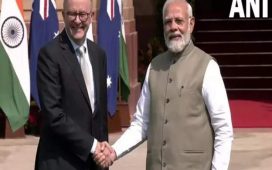Ten years later, very little remains of that zeal. The BJP’s 2024 manifesto still promises to “reform, perform, transform.” But the few specifics it offers on the economy are modest — such as automatic approvals for standard housing designs. Gone are the days when Modi pledged to change everything from inefficient markets in labor and farm produce to entire sectors like banking.
And yet, the appetite for a third term for the Indian leader is very high in the global financial industry. “Modi has done an unbelievable job in India,” JPMorgan Chase & Co. Chief Executive Officer Jamie Dimon said Tuesday at the Economic Club of New York. Both Goldman and JPMorgan are predicting a deluge of overseas capital after general elections are over on June 4. (The BJP is favorite to win the contest.)
Still, this is the start of a new compact between markets and Modi, one in which investors are betting on what he won’t do, rather than what he will.
The first belief is that while Modi 3.0 may take a more authoritarian turn, the Indian leader won’t follow the lead of China’s President Xi Jinping. The stock market will still have to read the tea leaves to figure out which business group is likely to be blessed with juicy contracts and favorable policy, but there is little risk of New Delhi turning the screws on the private sector. In other words, no nasty surprises like Beijing’s crackdown on its technology industry.
And that should be good enough for investors. After all, China hasn’t made them money in three years. India — and Modi — have.
 Bloomberg
BloombergThe second understanding is that the Indian strongman will not be like the Turkish President Recep Tayyip Erdogan, who has been forced to give up his push for ultra-low interest rates, but not before his unorthodox policies sparked an inflation crisis. Even during the pandemic, New Delhi stuck to a fairly conservative fiscal stance whose only pro-poor flourish was free food rations. And it did that in the face of an anemic job market that’s still plagued by low-quality work. Young graduates are nine times more likely to to be unemployed than those who can’t read or write.
Yet, Modi is not inclined to take the opposition parties’ bait on expanding the welfare state beyond free food. He would rather face the country’s disillusioned youth than annoy bond vigilantes. Speaking in an election rally this week, Modi said that the Congress Party would “calculate the gold with mothers and sisters,” and redistribute it among Muslims and “infiltrators.” It doesn’t matter that the opposition group has said nothing of that sort. What markets heard is this: The Indian prime minister doesn’t have to pursue profligate — or even populist — fiscal policies to remain popular in the country’s poor, overpopulated north.
It’s reassuring to fixed-income investors who will be raising their paltry exposure to India’s $1.2 trillion public debt as it enters JPMorgan’s global indexes from June. The emergence of a new set of buyers will allow local banks, currently the largest holders of government securities, to offload some of their exposure and put the liquidity at work where there’s greater risk and higher returns.
And that brings us to what Modi will actually do if he does emerge victorious with a sizable majority: a lot of investment, with the help of discretionary incentives and protective trade barriers.
There’s no dearth of balance sheets to execute the prime minister’s vision of Indian growth with Chinese characteristics. Gautam Adani, the tycoon close to Modi, is ready to do everything: ports, airports, electricity, gas, roads, slum redevelopment, metals, drones, ammunition and missiles. And he isn’t alone. The Tata Group wants to be big in everything from aviation to semiconductors, while Mukesh Ambani’s Reliance Industries Ltd. wants to own 1.4 billion Indians’ digital lives and retail spending. JSW Steel Ltd.’s Sajjan Jindal sees opportunity in electric cars, even as the government lays out the red carpet for Tesla Inc. They are the Big Four in the national team to watch.
There is a good reason why the agenda is no longer about reform. After all, Modi tried in his first term to make it easier for investment projects to acquire land. That effort failed. Then the prime minister attempted to rewire the agricultural markets. He was beaten again, not by political opposition, but by grain farmers in the north. The bankruptcy reforms of 2016 have been hijacked by vested interests.
The BJP government passed new labor laws in 2020, codifying 29 separate legislations into four. Four years later, they’re still being promised as an impending reform when they have little to offer, especially on social security. Healthcare, too, remains underfunded, despite an estimated death toll of nearly 5 million during Covid-19. In a country where 90% of the population doesn’t even earn the average income of $2,800 a year, people can’t afford steep out-of-pocket medical expenses. They would rather the government collected taxes and provided universal healthcare free of cost.
(The author’s views are personal and not necessarily reflect the opinion of The Economic Times)









